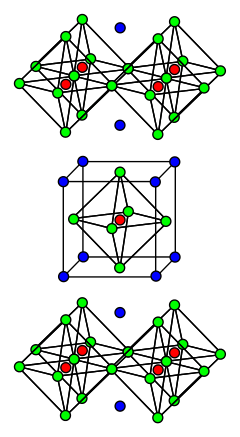Strontium ruthenate
 The unit cell of the layered perovskite structure of strontium ruthenate. Ruthenium ions are red, strontium ions are blue, and oxygen ions are green. | |
| Properties | |
|---|---|
| Sr2RuO4 | |
| Except where otherwise noted, data are given for materials in their standard state (at 25 °C [77 °F], 100 kPa). | |
| Infobox references | |
Strontium ruthenate (SRO) is an oxide of strontium and ruthenium with the chemical formula Sr2RuO4. It was the first reported perovskite superconductor that did not contain copper.[1][2] Strontium ruthenate is structurally very similar to the high-temperature cuprate superconductors,[3] and in particular, is almost identical to the lanthanum doped superconductor (La, Sr)2CuO4.[4] However, the transition temperature for the superconducting phase transition is 0.93 K, which is much lower than the corresponding value for cuprates.[1]
High-quality crystals of strontium ruthenate are synthesized using a floating zone method in a controlled atmosphere with ruthenium as flux. The perovskite structure can be deduced based on powder x-ray diffraction measurements. Strontium ruthenate behaves as a conventional Fermi liquid at temperatures below 25 K.[2]
Superconductivity
Superconductivity in SRO was first observed by Yoshiteru Maeno and his group in 1994 when they were looking for high temperature superconductors with structures similar to the cuprates. Unlike the cuprates, SRO displays superconductivity even in the absence of doping.[3] The superconducting order parameter in SRO has been shown to exhibit signatures of time-reversal symmetry breaking,[5] and hence, it can be classified as an unconventional superconductor.
Sr2RuO4 is believed to be a fairly two-dimensional system, with superconductivity occurring primarily on the Ru-O plane. The electronic structure of Sr2RuO4 is characterized by three bands derived from the Ru t2g 4d orbitals, namely, α, β and γ bands, of which the first is hole-like while the other two are electron-like. Among them, the γ band arises mainly from the dxy orbital, while the α and β bands emerge from the hybridization of dxz and yz orbitals. Due to the two-dimensionality of Sr2RuO4, its Fermi surface consists of three nearly two-dimensional sheets with little dispersion along the crystalline c-axis and that the compound is nearly magnetic.[6]
Early proposals have suggested that superconductivity is dominant in the γ band. In particular, the order parameter in the momentum space exhibits k-dependence phase winding which is characteristic of time-reversal symmetry breaking. This peculiar single-band superconducting order is expected to give rise to appreciable spontaneous supercurrent at the edge of the sample. Such an effect is closely associated with the topology of the Hamiltonian describing Sr2RuO4 in the superconducting state, which is characterized by a nonzero Chern number. However, scanning probes have so far failed to detect expected time-reversal symmetry breaking fields generated by the supercurrent, off by orders of magnitude.[7] This has led some to speculate that superconductivity arises dominantly from the α and β bands instead.[8] Such a two-band superconductor, although having k-dependence phase winding in its order parameters on the two relevant bands, is topologically trivial with the two bands featuring opposite Chern numbers. Therefore, it could possibly give a much reduced if not completely cancelled supercurrent at the edge.
References
- 1 2 Maeno, Yoshiteru; H. Hashimoto; et al. (1994). "Superconductivity in a layered perovskite without copper" (PDF). Nature. 372 (6506): 532–534. Bibcode:1994Natur.372..532M. doi:10.1038/372532a0. Retrieved 16 April 2012.
- 1 2 Yanoff, Brian (2000). Temperature dependence of the penetration depth in the unconventional superconductor Sr2RuO4 (PDF). University of Illinois at Urbana-Champaign.
- 1 2 Wooten, Rachel. "Strontium Ruthenate". University of Tennessee-Knoxville. Retrieved 16 April 2012.
- ↑ Maeno, Yoshiteru; Maurice Rice; Manfred Sigrist (2001). "The intriguing superconductivity of Strontium Ruthenate" (PDF). Physics Today. 54 (1): 42. Bibcode:2001PhT....54a..42M. doi:10.1063/1.1349611. Retrieved 16 April 2012.
- ↑ Kapitulnik, Aharon; Jing Xia; Elizabeth Schemm Alexander Palevski (May 2009). "Polar Kerr effect as probe for time-reversal symmetry breaking in unconventional superconductors". New Journal of Physics. 11 (5): 055060. arXiv:0906.2845
 . Bibcode:2009NJPh...11e5060K. doi:10.1088/1367-2630/11/5/055060. Retrieved 17 April 2012.
. Bibcode:2009NJPh...11e5060K. doi:10.1088/1367-2630/11/5/055060. Retrieved 17 April 2012. - ↑ I.I. Mazin and D.J. Singh, Physical Review Letters 79, 733 (1997)
- ↑ Hicks, Clifford W.; et al. (2010). "Limits on superconductivity-related magnetization in Sr2RuO4 and PrOs4Sb12 from scanning SQUID microscopy". Physical Review B. 81 (21). arXiv:1003.2189
 . Bibcode:2010PhRvB..81u4501H. doi:10.1103/PhysRevB.81.214501. Retrieved 22 December 2012.
. Bibcode:2010PhRvB..81u4501H. doi:10.1103/PhysRevB.81.214501. Retrieved 22 December 2012. - ↑ Raghu, S.; Marini, Aharon; Pankratov, Steve; Rubio, Angel (2010). "Hidden Quasi-One-Dimensional Superconductivity in Sr2RuO4". Physical Review Letters. 105 (13): 136401. arXiv:1003.3927
 . Bibcode:2010PhRvL.105b6401B. doi:10.1103/PhysRevLett.105.026401.
. Bibcode:2010PhRvL.105b6401B. doi:10.1103/PhysRevLett.105.026401.